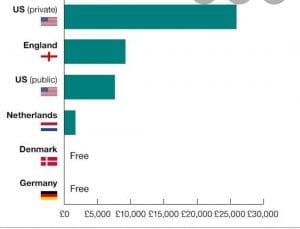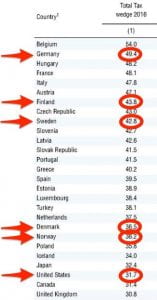The staggering cost of higher education in the United States has prospective college students wondering whether going to college is worth the expense. While conventional wisdom still points to the benefits of having a college degree, more students and their families are seeking alternatives to lower their college tuition bills. Some Americans are even looking abroad, as some countries offer free tuition to international students and programs of study entirely in English.Why the United State do not have free college education yet? If America were to move to a tuition free college policy, where the money come from? The object of this blog is to explain why the idea of free college education system works better in Sweden than what we have nationally in the U.S? https://www.investopedia.com/articles/personal-finance/080616/6-countries-virtually-free-college-tuition.asp
According to the concept map we have been creating with my group, which talk about the potential solution of higher college education. We have decided to look up on some countries where higher college education is free in order to see if those countries are way better than the U.S. We have been able to gather some sources.

Talking about free higher college education, the United States tuition fees are higher than most countries as we can see in the graphic. This graphic ties into my argument by showing the huge among tuition fees cost for student also by demonstrated that there are some countries that have free college education and that there are better than the U.S. So the question is why can’t the U.S vote for free college education? Countries like Germany , Sweden and so on have free college and this money come from the government. https://www.google.com/amp/s/www.washingtonpost.com/news/grade-point/wp/2016/08/26/three-ways-to-fix-college-tuition-pricing/%3foutputType=amp
As the US faces a higher education affordability crisis, students from developed countries do not pay anything for college. Of the 36 developed, democratic countries that currently make up the organization for economic cooperation and development (OECD), seven of them subsidize tuition for public colleges and universities. The US, in contrast, charge the most money to attend colleges among OECD countries. The average annual tuition for US public colleges cost more than $6,000, according to a 2011 report from OECD. businessinsider.com
- If we look at the those countries that have free college education and the US, we can see a huge differences. On one hand we have countries like Germany, Denmark, Sweden, that have free college on the other hand we have the US with who’s tuition are going up years after years. https://www.investopedia.com/articles/personal-finance/080616/6-countries-virtually-free-college-tuition.asp.
If America were to move to a tuition-free college policy, where would the money come from? The short and simple answer is taxes. Who gets taxed seems to vary based on who is talking, but it seems certain that the upper echelons of American society will see increased taxes if this passes. There is a likelihood that it will increase the upper-middle-class as well. Or maybe it will all come from Wall Street speculation taxes. The point is, all we know is that someone will pay these dues through taxes. The uncertainty of who will carry the burden is not making many Americans comfortable. https://www.collegeraptor.com/find-colleges/articles/affordability-college-cost/pros-cons-tuition-free-college/
European countries often differ greatly from the US in substantive ways. Their college enrollment percentages, for example, are much lower than in America.Europe also traditionally has higher taxes than the US, which allows those countries to offer additional social services.The Organisation for Economic Co-operation and Development (OECD) released its 2017 report on the tax burden on earnings among member countries.Their report ranks countries by their tax wedge percentage. The tax wedge is the dollar measure of the income tax rate. The countries below with the red arrows offer free college, with the exception of the US. There are other European countries that offer free college, but the countries below are the most well-known examples. https://www.businessinsider.com/how-do-european-countries-afford-free-college-2017-4

- https://www.businessinsider.com/how-do-european-countries-afford-free-college-2017-4. It is true that the idea of free college works better in Germany, Sweden than in America. The tuition has been payed by the State. the fact that the taxes are higher they still find a way to make free college education.
Finally, the government must work to reduce tuition costs because the current system of financial aid is not adequate. Many middle-class students find themselves in a predicament when filling out financial aid forms prior to enrolling in college. Many middle-class families have the paradoxical problem of having too high a net income to qualify for financial aid, but still do not have enough money to pay for college out of pocket. Students are then forced to rely on academic scholarships and loans. Academic scholarships are extremely competitive and often aren’t enough to pay for the entirety of a tuition bill. Currently, there are government funds available for students, but it’s become apparent that these simply aren’t enough. These grants have come under fire in the recent elections. Presidential candidate Mitt Romney frequently stated his plans to reduce the amount of money budgeted for Pell Grants and similar government grants. Grants do not need to be repaid by the recipient. The government needs to look at what other countries do for allowing free college education.
I like how you related the US to other countries in this way “The US, in contrast, charge the most money to attend colleges among OECD countries. The average annual tuition for US public colleges cost more than $6,000,” I had no idea this was the US’ relation via statistics.
REFLECTION***
Reflection: With the first graph that you provided, I was able to recognize that the U.S has one of the most costly higher education systems in the world. As we can infer through the colorful graph that our country needs a change in the current education system in which most Americans seen affected by high rates that obstruct new students from getting involved in higher education for fear of being in debt. I also like the argument that you display that some European countries have free higher education for their high rate of taxes. It helps me to understand that taxes play an essential role in creating higher education more affordable.
Reflection: I enjoyed reading this blog, the way you have compared other places to the United States truly does it. Comparing how other schools tuitions in other states, are so much cheaper than the US.
Inquiry: How will you get people onboard with paying more taxes? People are already upset with paying taxes right now, and you want them to pay more? Around 1/4th of state spending is used on education. Is that not enough?
https://www.cbpp.org/research/state-budget-and-tax/policy-basics-where-do-our-state-tax-dollars-go
inquire: when you mentioned this by saying “Presidential candidate Mitt Romney frequently stated his plans to reduce the amount of money budgeted for Pell Grants and similar government grants.“ this link will help see what other plans are also being brought to the table from other candidates and how they plan on doing it since college debt is increasing more and why are they choosing these routes what effects could they bring as well. https://www.nasfaa.org/2020
Inquiry: Your essay offered great points in terms of supporting your argument. There are several strategies that the source below will help introduce, in a effort to add more options to your solutuion.http://www.uncompromisingedu.com/2017/05/25/eight-strategies-to-make-higher-education-more-accessible/
Reflect: This shows how behind the U.S. is on free higher education. Education is an important part of how to function in society, and without higher education, we wouldn’t get livable wages.